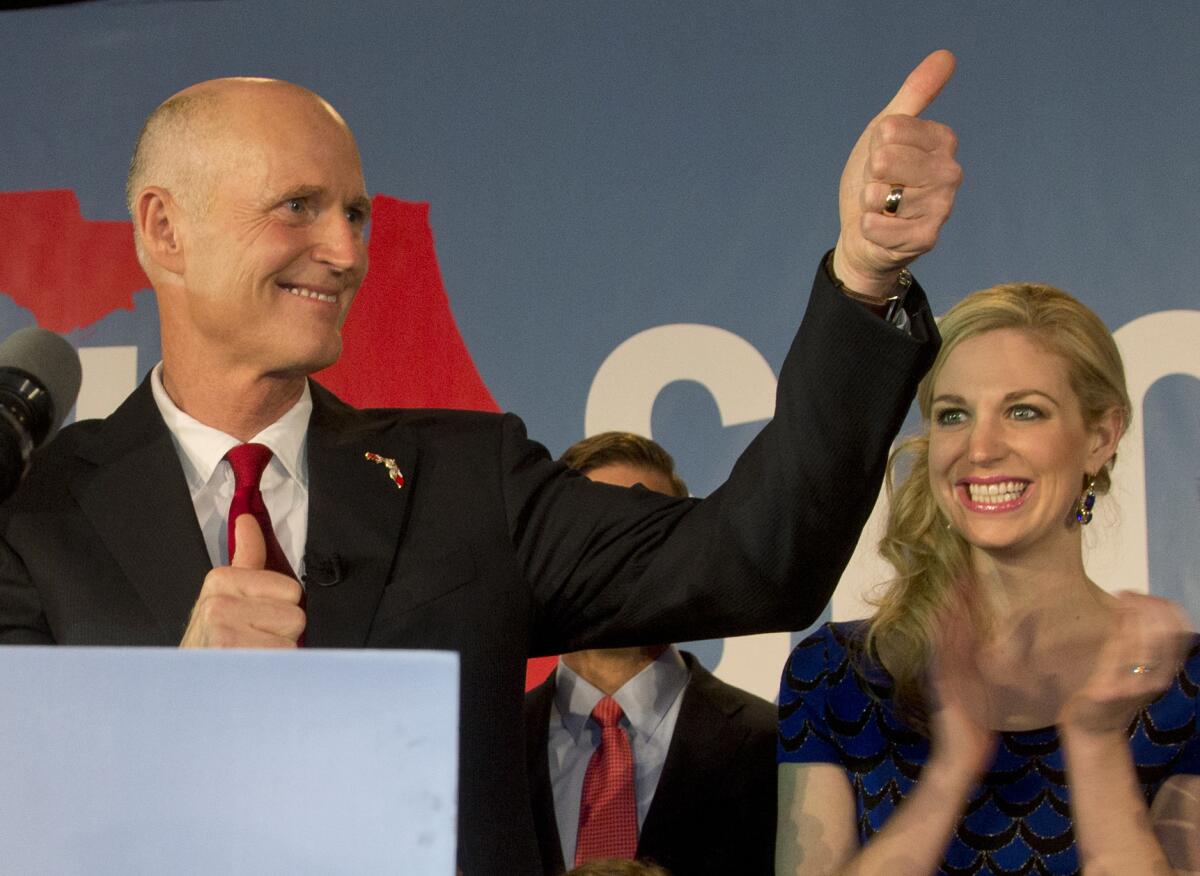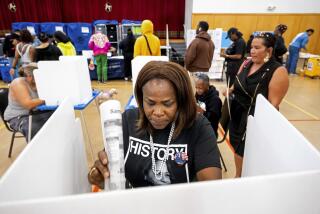Op-Ed: How to break the hold of the two-party system

Florida Gov. Rick Scott gives a thumbs up to the crowd after defeating Democratic challenger, former Republican Charlie Crist, in Bonita Springs, Fla.
- Share via
Republican Rick Scott won the Florida midterm election for governor, but 51.8% of voters did not want him. Democrat Gina Raimondo was elected governor of Rhode Island, despite 59.2% of voters choosing someone else. What is up with the math of the midterms?
The midterm elections are an example of what is called a first-past-the-post voting system. This is an elegant way to run an election because it results in a clear and concise overall winner (and the occasional, very rare tied result). This is partly because each voter can convey only a single piece of information: his or her preferred winner. One person must get the most results, and so they win.
But the problem is, someone can be elected even if a majority of the voters do not want them. Even ignoring people who did not vote, of those who actually cast a ballot for Massachusetts governor, 51.5% did not vote for Republican Charlie Baker. He was still elected though, because the 48.5% of people who did vote for him was more than the 46.6% who voted for Democrat Martha Coakley and 3.3% for independent Evan Falchuk. What is counted in first-past-the-post elections is only those who want a candidate, not those who do not want them.
This means that if you vote for a smaller party, then you are effectively throwing your vote away. Unless the party you are voting for has a shot at winning the most votes, then the reality is your vote won’t count. This makes it nearly impossible for independents and new parties to get a foothold — and results in the two-party system that has dominated U.S. politics for decades.
A better system would allow voters to put their support behind a smaller party while still expressing their preference between the two big parties with a chance of winning. There is a system that does exactly this and it is called ranked-choice voting. The only problem is that it requires a slightly more complicated method of deciding the winner.
This is how elections are currently decided: The votes for each candidate are counted, and whoever has the most votes wins.
In a ranked-choice vote, instead of merely stating their top choice, voters rank the candidates in their order of preference. This kind of election is decided in a two-step process. Initially, the first-choice votes for each candidate are counted. If one of them has more votes than all of the others combined, he or she wins. If there is not such a clear winner, then the candidate with the fewest votes is removed, and his or her votes are passed on to whoever voters marked as their next choice, and the count is repeated until there is a clear winner.
What this means is that your vote counts toward your preferred candidate until that person is out of the race. At that point, instead of your vote no longer counting, it switches over to your second preference. Then your third and so on. Should you wish, you can have the two candidates most likely to win as your last two on your ballot and still express a preference for one over the other. Ranked-choice voting could break the two-party deadlock because it allows voters to express a more nuanced opinion about what politics they support.
This is not just theoretical math, either. Australia has used ranked-choice voting since 1918 and it has been used in Britain’s House of Lords. Even some smaller state elections in the U.S. use it. In 2006 Minneapolis approved the use of ranked-choice voting for municipal offices. There have also been ranked-choice elections in cities in California, North Carolina, Colorado, Maine and Maryland. But never for any of the major positions in the federal government.
If adopted, ranked-choice voting would also remove the risk of vote-splitting. Even though Democrat Gina Raimondo did win the Rhode Island gubernatorial election against Republican Allan Fung, it was close: 40.8% to 36.3%. The remaining 21.4% was swept up by Robert Healey of the Cool Moose Party. We do not know who those 21.4% of people would have voted for otherwise because the CMP is fairly politically central. But what if they were tempted away from Fung’s voter base? If there are two different candidates at the same end of the political spectrum they can split voters between them, meaning one focused candidate at the other end can beat them both, despite being less popular.
In these midterms, Robert Healey and his Cool Moose Party are a bit of an anomaly: a genuine different option that actually took a decent slice of the vote. But Healey still failed to get nearly enough votes to win, and his entire campaign only cost him $35. In his words: “If we only spent $75, $80, we might’ve won the race.” Until there is a more representative form of voting in the U.S., independents and Cool Moose are likely to remain as outliers.
Matt Parker is a mathematician and stand-up comic in London. His book, “Things to Make and Do in the Fourth Dimension,” is out next month.
Follow the Opinion section on Twitter @latimesopinion
More to Read
Sign up for Essential California
The most important California stories and recommendations in your inbox every morning.
You may occasionally receive promotional content from the Los Angeles Times.













